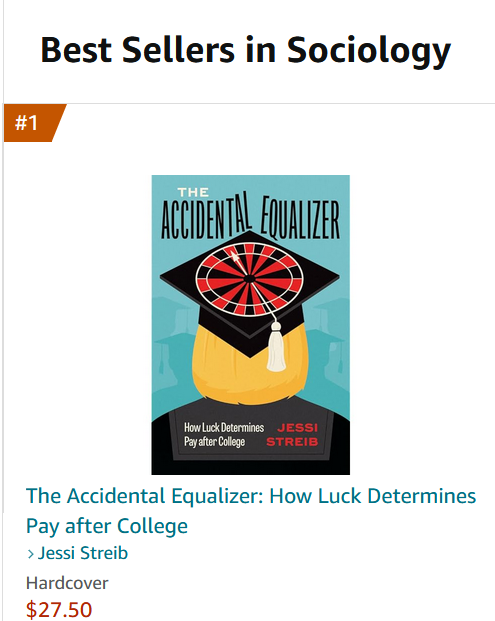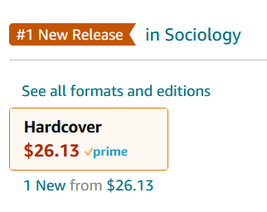Published by the University of Chicago Press
Zelizer Economic Sociology Book Award, Honorable Mention
Contexts summary here.
There’s a fact so surprising as to be nearly unbelievable: students from disadvantaged and advantaged class backgrounds who graduate from the same college go on to earn the same amount. This fact is nearly unbelievable because it upends much of what we know about how inequality is reproduced. Class-advantaged students tend to know more professionals, maintain higher GPAs, complete more internships, understand more professional norms, and display more status symbols than their class-disadvantaged peers. Each of these factors is thought to matter for how much job-seekers are paid. But despite these inequalities, class-advantaged and class-disadvantaged students go onto receive equal pay.
How does this happen? This book shows that inequality is transformed into equality through a newly unearthed opportunity structure: a luckocracy. Luckocracies hide information about where and how to get ahead from people of all classes, and they evaluate individuals using class-neutral criteria and processes. Because information is hidden, students from all class backgrounds must guess how to get ahead, and because they are evaluated in class-neutral ways, their guesses are equally likely to pay off. In this system, those who get ahead aren’t those with the most resources. They’re the ones who guess well—the ones who are lucky.
The book traces how the luckocracy plays out in the mid-tier business labor market and among students graduating from non-elite colleges. It reveals how little information students have about how to get ahead—how earnings are often hidden until students are offered a job and how hiring criteria is hidden, varied, and contradictory, leaving students forced to guess how to present themselves to each hiring agent. It depicts how at every turn employers set up a class-neutral system: one that ignores status symbols, defines skills and fit in ways people from all classes can meet, blocks negotiations, and doesn’t allow students’ connections to advantage them in the ways we’ve come to expect. And it follows students as they search for jobs and navigate their first year at work, showing, repeatedly, how the luckocracy neutralizes class-advantaged students’ strategies and resources, throwing them into the same position as their class-disadvantaged counterparts.
But it also shows the dark sides of this equalizing system. It is only by disadvantaging students from all classes that earnings equalization comes to be. This raises the question: is earnings equality worth the price?
Zelizer Economic Sociology Book Award, Honorable Mention
Contexts summary here.
There’s a fact so surprising as to be nearly unbelievable: students from disadvantaged and advantaged class backgrounds who graduate from the same college go on to earn the same amount. This fact is nearly unbelievable because it upends much of what we know about how inequality is reproduced. Class-advantaged students tend to know more professionals, maintain higher GPAs, complete more internships, understand more professional norms, and display more status symbols than their class-disadvantaged peers. Each of these factors is thought to matter for how much job-seekers are paid. But despite these inequalities, class-advantaged and class-disadvantaged students go onto receive equal pay.
How does this happen? This book shows that inequality is transformed into equality through a newly unearthed opportunity structure: a luckocracy. Luckocracies hide information about where and how to get ahead from people of all classes, and they evaluate individuals using class-neutral criteria and processes. Because information is hidden, students from all class backgrounds must guess how to get ahead, and because they are evaluated in class-neutral ways, their guesses are equally likely to pay off. In this system, those who get ahead aren’t those with the most resources. They’re the ones who guess well—the ones who are lucky.
The book traces how the luckocracy plays out in the mid-tier business labor market and among students graduating from non-elite colleges. It reveals how little information students have about how to get ahead—how earnings are often hidden until students are offered a job and how hiring criteria is hidden, varied, and contradictory, leaving students forced to guess how to present themselves to each hiring agent. It depicts how at every turn employers set up a class-neutral system: one that ignores status symbols, defines skills and fit in ways people from all classes can meet, blocks negotiations, and doesn’t allow students’ connections to advantage them in the ways we’ve come to expect. And it follows students as they search for jobs and navigate their first year at work, showing, repeatedly, how the luckocracy neutralizes class-advantaged students’ strategies and resources, throwing them into the same position as their class-disadvantaged counterparts.
But it also shows the dark sides of this equalizing system. It is only by disadvantaging students from all classes that earnings equalization comes to be. This raises the question: is earnings equality worth the price?





